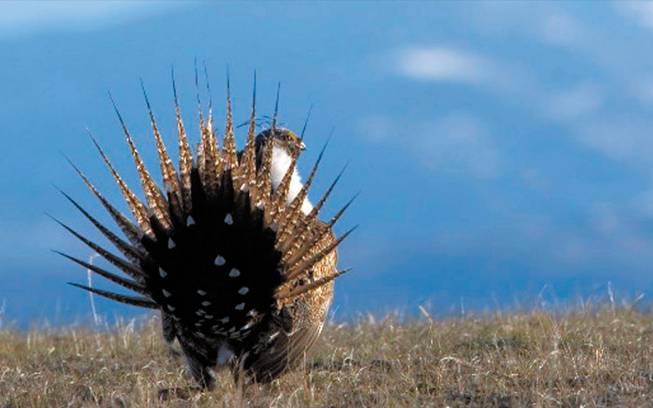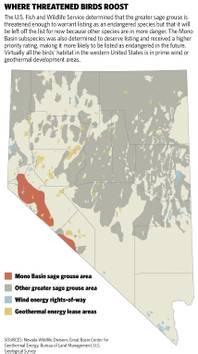It’s man vs. bird in quest for power
The sage grouse isn’t endangered right now, but the state’s plans for alternative energy may change that

AP photo/Wyoming Game and Fish
While biologists and politicians debate whether the sage grouse should be labeled an endangered species, 10 Western states allow hunters to take aim at the reclusive, ground-dwelling bird.
Saturday, March 6, 2010 | 2:01 a.m.
Sun coverage
The basics about these birds
The greater sage grouse lives in 11 states in the Intermountain West, including Nevada. The birds were long an important food source for Native Americans. In the late 19th and early 20th centuries, they were so plentiful that flocks were known to “blacken the sky.” But the speckled, chicken-sized bird’s population has declined after decades of habitat destruction. The birds need large tracts of unbroken sagebrush to be able to flourish. Any construction that breaks up that habitat can splinter a flock or constrict the amount of habitat the bird uses, ultimately leading to declining population. Today the population is estimated to be 90 percent smaller than it once was. Wildlife biologists think 100,000 to 500,000 greater sage grouse are in the United States. The bird has been wiped out of Arizona, New Mexico, Nebraska, Oklahoma and British Columbia. Half the bird’s original habitat is gone and the rest is threatened by oil and gas development, renewable energy plants, power lines and wildfires fueled by invasive plants such as cheatgrass. Sage grouse are what’s called an umbrella species, one which covers a large geographic area along with other important and sometimes rare species. If the greater sage grouse populations are healthy, the other plant and animal populations tend to be healthy, too.The future of Nevada is tied to the future of the sage grouse because the bird lives in a lot of the same areas that are expected to be used for wind, solar and geothermal energy.
And although the U.S. Fish and Wildlife Service decided not to add the bird to the endangered species list Friday, it acknowledges that federal protection is warranted. The agency basically said it was precluded from adding the bird to the list because species that are more threatened are being given priority.
“We have a window of several years before we reach a point in time when a listing (for the greater sage grouse) would be imminent,” Tom Strickland, assistant interior secretary for fish, wildlife and parks, said Friday.
The “warranted but precluded” designation for the sage grouse is, in effect, a formal warning to other state and federal agencies that the threat to the species is serious and other actions need to be taken to protect it, explained Steven Robinson, who oversaw the endangered species program in the Reagan administration and has served as an adviser to former Govs. Bob List and Kenny Guinn.
Environmental and conservation groups had mixed reactions to Friday’s announcement. Some condemned it as too big a gamble for a seriously threatened species. If listing it as endangered is warranted, then the sage grouse should be listed as such, they said.
But others think the bird is a little better off than it had been before Friday because the designation should force developers and state and federal agencies to be more careful when dealing with its habitat.
In Nevada, 60,000 to 80,000 greater sage grouse live in the northern two-thirds of the state. The population here, as well as 10 other states, is robust enough to support limited hunting, officials maintain.
But a genetically distinct subspecies of the greater sage grouse lives in central western Nevada and eastern California. Wildlife experts estimate there are fewer than 5,000 Mono Basin sage grouse left. The species lives in the same habitat and has similar living patterns as the greater sage grouse.
In a separate decision Friday, the Wildlife Service gave the Mono Basin subspecies a higher priority candidate designation, which means it is more likely to be listed as endangered.
As is true in other Western states, the sage grouse habitat in Nevada has been diminished by grazing, oil and gas drilling, invasive species and wildfires. But wildlife experts, birders and environmentalists warn the number of birds in Nevada could quickly drop as new wind farms and geothermal plants begin to dot the sagebrush steppe valleys and mountain meadows the birds call home.
Renewable energy development in general, and wind farms in particular, are considered the largest new threat to the greater sage grouse.
The White House has promoted unprecedented levels of renewable energy development as a way to spur job growth and combat climate change. Wind energy alone is expected to provide 20 percent of America’s electricity by 2030, according to the Energy Department. But out West, where most of the available publicly owned land is situated, those plans are pitted against a growing desire to preserve wild spaces and the plants and animals that live in them.
Virtually all of the greater sage grouse’s remaining habitat is within prime renewable energy territory. The BLM has processed at least 41 wind energy applications and 361 geothermal leases in Nevada. NV Energy and LS Power have rights of way to build a large cross-state transmission line that runs through greater sage grouse habitat. Forty-three percent of prime brood-rearing habitat, 36 percent of the nesting sites and 38 percent of the winter habitats in Nevada are within 2 miles of renewable energy development areas. At least 5 percent of the nesting, breeding and winter habitat for Nevada’s greater sage grouse is threatened by planned renewable energy projects, according to Nevada Wildlife Division.
Wildlife managers and environmentalists fear that if land management practices aren’t improved, the growing renewable energy industry will wipe out all but a few populations of greater sage grouse across the intermountain West.
Greater sage grouse and energy installations don’t mix well. Decades of research on the effect of oil and gas wells on greater sage grouse have shown the wells consistently led to die-offs.
Although the birds usually return every year to the same nesting and breeding areas, greater sage grouse will avoid their historical homes if an oil well, road or power line is built within a few miles of their preferred spots, researchers have found.
That leaves the remaining birds competing for a smaller amount of habitat, catching diseases from overcrowding or making due with more dangerous areas. Within a few years of a new oil rig being built in greater sage grouse territory, the bird’s population typically plummets.
Although studies haven’t yet begun, renewable energy projects are expected to cause some of the same problems and some new ones.
The noise from geothermal plants and wind farms is expected to drive out sage grouse just as noisy oil wells have. And there’s also a theory that the “shadow flicker” effect from whirling wind turbine blades will make the birds think there’s a massive flock of raptors overhead, making them flee.
Energy development also has an indirect effect on the sage grouse. Scraping the desert to make way for roads and transmission lines allows the introduction of invasive species. These can spread into undisturbed areas and choke out the plants the grouse need for shelter and food. Invasive plants such as cheatgrass lead to bigger and more frequent wildfires, which kill the birds and their habitats. The effect of these invasive plants is usually irreversible.
“Warranted but precluded” means sage grouse gets none of the stringent legal protections available to listed species under the Endangered Species Act, but the designation is an indicator to states and industries that they will need to work harder to keep the bird off the list.
State and federal wildlife biologists will be required to watch the sage grouse populations more closely. This doesn’t mean all renewable energy development or other potential changes will have to stop, but the state and BLM will need to be careful about where they allow potentially disruptive actions to occur.
This multiuse approach should give them the chance to better understand how renewable energy projects and other activities affect the bird, land managers said Friday. This is supposed to lead to improved guidelines on renewable energy developments, such as large buffer zones around mating, nesting and brood-rearing sites. And it means some crucial habitat spots may become off-limits.
“It won’t be a big game changer, but it will mean anybody in renewables or any development will have to take precautions,” said Robinson, former chief of the endangered species program. “The federal agencies are going to make them consider impacts to the greater sage grouse, but it won’t stop anything in its tracks.”
Friday’s decision means that energy developers in sage grouse territory won’t be saddled with the expense of more intensive wildlife surveys and delays from increased bureaucratic requirements.
The “warranted but precluded” designation also means the bird can still be included in state-managed hunts, but the Wildlife Service will collect more data on the greater sage grouse and will re-evaluate annually whether it deserves a higher priority status.
The Governor’s Sage Grouse Conservation Team is expected to release renewable energy siting and construction guidelines within a month. The group is expected to recommend a buffer zone of two to four miles between key sage grouse habitats and proposed energy developments as well as limits on disturbing the bird during certain times of year.
But it’s unclear whether the BLM would have to listen to the state’s recommended standards on land under its jurisdiction, said Bret Birdsong, a Boyd Law School professor.
The BLM’s rejection of state wildlife officials’ advice caused conflict in Nevada. The BLM and the Nevada Wildlife Division have been at odds over the proposed site of a controversial wind power plant east of Ely.
The Spring Valley Wind Project is expected to use more than 8,500 acres and would include up to 75 wind turbines. The project's initial proposed site was within a quarter-mile of three sage grouse breeding sites. The Wildlife Division objected to the wind farm’s proximity to the sage grouse habitat. Division Director Kenneth Mayer said in letters to the BLM that the wind farm needed to be at least two miles from the sage grouse habitat. He accused the agency of ignoring science that backed the state’s request.
The Spring Valley wind developer has resolved many of the concerns of state fish and wildlife officials by moving the planned wind farm farther away from active sage grouse breeding sites, but the Center for Biological Diversity and other groups are threatening to sue the BLM if it doesn’t make enough concessions for the sage grouse habitat and address other concerns.
Mayer said Friday he was disappointed in the federal decision regarding the sage grouse designation. He said in a statement that although the state has worked hard to identify problems and find solutions to improve conditions for the bird, more than half the sage grouse territory is under federal jurisdiction.
“We need all of the conservation partners in the state to step up to protect and restore the sagebrush ecosystem,” he said in a statement. “It is going to take a huge effort to improve and restore habitat, and protect the bird to stave off a threatened listing.”
Discussion: comments so far…
Comments are moderated by Las Vegas Sun editors. Our goal is not to limit the discussion, but rather to elevate it. Comments should be relevant and contain no abusive language. Comments that are off-topic, vulgar, profane or include personal attacks will be removed. Full comments policy. Additionally, we now display comments from trusted commenters by default. Those wishing to become a trusted commenter need to verify their identity or sign in with Facebook Connect to tie their Facebook account to their Las Vegas Sun account. For more on this change, read our story about how it works and why we did it.
Only trusted comments are displayed on this page. Untrusted comments have expired from this story.
No trusted comments have been posted.
Post a comment
Most Popular
- Viewed
- Discussed
- E-mailed
- $632 for a room? Must be time for CES
- Husband cuckolded by Ensign rips rising Santorum
- UNLV basketball moves up to No. 12 in both the AP and coaches’ polls
- Sisters earn respect on the wrestling mat
- Our president is underappreciated
- Leaders say Las Vegas isn’t likely to boom again in 2012, but there’s reason for hope
- Fire causes $200,000 damage to McDonald’s on the Strip
- Pittsburgh transfer forward Khem Birch commits to UNLV
- Florida Legislature’s decision could have affect on Las Vegas casino companies
- Las Vegas HS quarterback Hasaan Henderson picks UNR over UNLV
Blogs
The Kats Report
Song-and-dance ace Rick Faugno brings his one-man show to the Lounge at the Palms
Talking Points
Bowl Pick'em Against The Spread National Championship Edition
Elsewhere
What will become of Hooters hotel in Las Vegas?
Rolling the dice: One of the most depressed states is going all out to attract new industries
Governor reveals plan to develop Aqueduct, add gambling
The Kats Report
Three movers and shakers to watch in 2012 (2 Comments)
The art of the deal: LVAM, UNLV partner to revive dormant museum collection (1 Comment)
The Sun
Locally owned and independent for more than 50 years.




"Renewable energy development in general, and wind farms in particular, are considered the largest new threat to the greater sage grouse."
---------------------------------
Amazing Remember when Harry Reid told us he would take care of all of these rule for renewable energy?
Guess Harry forgot about the greater sage grouse.
Lets go ahead and add the darn thing to the endangered species list and than watch all the eco wieners tap dance around the issue of how were gonna power our homes and businesses in the future.
HA HA HA HA
Firstly, why would ANYONE want to shoot these beautiful creatures, and secondly, there is plenty of desert out there for the energy plants and sage grouse to live together in harmony..
Wind power will make your bills go way up. The grid will need to be upgraded to accomidate the sporadic and unreliable energy output of wind turbines. As the democrats use Bush like tactics to give the nation's wealth away to energy developers, consider how much your rates will go up when we become a wind energy state. The democrats will not pay for those power upgrades...you will in your power bills. So as Mr. Obama continues to expedite the nation's wildlife to extinction to pay back the big energy lobby, consider that you will not even have cheap power. I thought Obama claimed to be environmental! Looks like he lied to us!
"March 5, 2010 by Christine McConville in Boston Herald
The region's electrical grid operator has determined that a $10 billion investment in transmission facilities would be needed to move energy from new wind farms to customers across New England."...http://bostonherald.com/business/general/view.bg?a...
GIVE ME A BREAK!! Don't ya think when the bird hear's people or trucks coming, they'll move to a new place? For this we are going to hold up supplying what we need? It doesn't say the bird will become extinct..it says we'll interupt it's home..
trust me - they'll move themselves!!!
What do we need? a bunch of expensive wind farms in questionably windy areas in Nevada that will have to be propped up by tax payer subsidies? Does the retiredyoungster even understand what he/she is supporting?
This has nothing to do with the grouse. This is about "ecology" groups wanting veto power over the use of our land and our resources. They never stop. Now they want to use a species that is not threatened on the assumption it might be?
It is a lot like global warming (change to climate change) causing all the cold weather. Reconciliation is now a simple majority. The book 1084 told us double speak was coming and now it has arrived.
Renewable energy is everywhere (sun & wind).
Producing power far away from consumption is for dirty power.
Half of the power that is created in rural areas will be lost in the transmission of that power over hundreds of miles.
Distributed Generation is the 'BIG IDEA' the escapes the power company. Production at the source of consumption is the true benefit of solar and wind.
NV Energy should 'rent' a solar system as an option customers.
Producing power in Wyoming from wind turbines and shipping it in new powerlines across Nevada to California will result in a 15 percent loss in the long travel alone. That of course will depend on local weather as well. Compare that to the point of use you get with distributed generation. Large scale renewables are the economic graveyard of our economic future. Without higher rates anb taxes, there is no future in it.
How did we get a democrat that hates wildlife so much??? Who voted for that? What kind of liberal president secures the grim fate of a species like that? The kind who is owned by the energy lobby!
Wind and solar will never work as reliable power sources.
Signed; Obamas cleen Coal Coalition.
Tasty little things.
This is a very, very disappointing decision. I'm underwhelmed by the job the US F&W has been doing so far. No vision...very sad.
the great lakes had a similiar problem when vast amounts of smelt, or alewives would wash upon the shore. they introduced coho salmon to the lakes to cut into the smelt population. it worked but the coho needed some speed as they werent able to control all the smelt. so they crossed the coho with a walleye yet this hybrid , the cowal, still didnt have enough strength. they crossed the cowal with a muskie, and called it a kowalski; but they couldnt teach it how to swim.
Thanks for the article Ms. Tavares. I just found so much irony in this. Here we have renewable energy coming in. Not withstanding the sage grouse issue, generally this type of industry is perceived as positive for the environment and the economy. Yet, we have the BLM, US Fish, Wildlife and Parks, and the State Wildlife Division all involved. We even have a Governor's Sage Grouse team. Certainly, a dillegent effort around the environmental considerations!
The irony? Well,here we have Recology, looking to train in 4000 tons of NON-RECYCLABLE trash (includes waste sludge, asbestos, tires) per day from California, 5 days a week for 95 years and dumping it in the Black Rock desert (Jungo Rd, Winnemucca). The site is in a seismic zone. Recology is looking to get an exception to Nevada statute to place their landfill closer to an active aquifier than code allows. The State Department of Wildlife has not been involved. The Govenor refuses to help because he can't mess with inter-state trade laws. Recology refuses to perform an environmental impact study, and local government won't make that a condition of their permit. The state Bureau of Air Pollution Control (BAPC) of the NDEP just issued Recology a final permit to build (more permits still needed).
When asked if they considered the impact of landfill fires on air pollution, The BPAC said they didn't because Recology didn't indicate fires were part of the normal operations of the landfill. When asked if the BPAC measured air polution risks in their model for this project from fugitive dust, the BPAC said the law does not allow for fugitive dust, so Recology will operate the landfill as to assure there is no fugitive dust. And I quote..."must operate such that no dust is removed from the site by wind". They also go on to note that they don't evaluate the impact of dust storms on the playa and any air pollution from the landfill because, again, the site must operate without any dust escaping. I certainly hope all the dust on the playa is paying attention to the law. Recology will need its' cooperation beyond their dust control techniques.
It's kind of like never testing an auto in a crash situtation because all of the drivers promise they'll operate in such a manner that they never crash. While there is more comedy I could share. I'll leave it at this.
Ironic. In the event the legal appeals, and Reid's new TRASH Act don't stop this, maybe I can round up some Sage Grouse to move into the landfill site so we can stop this thing.
Vote for getting the EPA involved in Jungo Rd:
http://bit.ly/cmtXYA
Get involved/informed/donate: www.nevadansagainstgarbage.com
Join our Facebook Group: http://bit.ly/dwMQCk
The Sage Grouse are great to eat.
In Northern Nevada we call them Sage Hens
You gotta be kiddin ? A bird over power plants? Stupid is is stupid does.
the only reason those birds are still here is because it's still cheaper to go to the Colonel's than it is to buy a gun to shoot grouse.
Can't you save this harmless creature ? Fund-raising to this bird, you can't be heartless if you are origin of nevadans.
Didn't harry reid used to hunt those things?